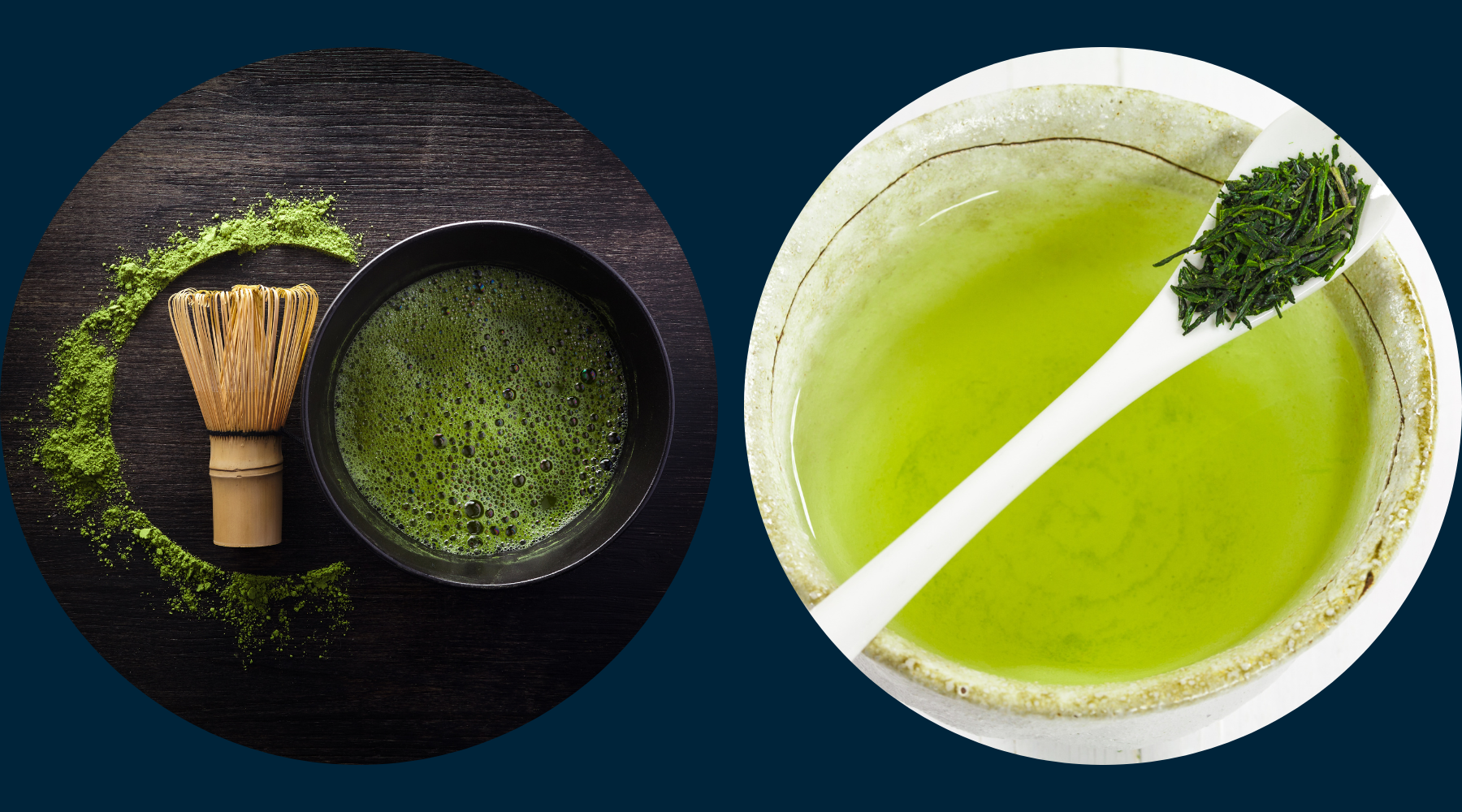
Matcha vs. Gyokuro: Unveiling the Differences
Posted on April 26 2023,

Matcha vs. Gyokuro: Unveiling the Differences
Introduction
Matcha and gyokuro are both renowned Japanese green teas that come from the camellia sinensis plant. But do you know the key differences between them? In this article, we'll delve into the fascinating world of these two tea varieties, comparing their origins, production, flavor profiles, health benefits, brewing techniques, culinary uses, and more.
So, let's dive in and discover which tea suits your taste buds and lifestyle!
The Origins
Matcha
Matcha, with its vibrant green color, dates back to the 12th century when Zen Buddhists introduced it to Japan from China. Initially used by emperors and the elite, then the Japanese tea ceremony, matcha tea soon became a popular everyday beverage. Today, it's recognized worldwide for its distinctive flavor and health benefits.
Gyokuro
Gyokuro, also known as "jade dew," is a high-quality green tea that originated in Japan in the 1800s. Like matcha, gyokuro is shade-grown, but its leaves are carefully hand-picked and then rolled into fine, needle-like shapes. This unique process gives gyokuro its distinct taste and appearance.
Subscribe to this blog's RSS feed using http://premium-health-japan.myshopify.com/blogs/news.atom
Production Process
Shade-Growing Technique
Both matcha and gyokuro are shade-grown, meaning they are cultivated under cover for about 20-30 days before harvesting. This practice increases chlorophyll content and reduces tannins, giving both teas their characteristic sweetness and umami flavor.
Harvesting and Processing
For matcha, the leaves are steamed, dried, and then ground into a fine powder. Gyokuro, on the other hand, is harvested, steamed, and then rolled into thin, needle-like shapes before drying. This difference in processing affects the teas' flavors and the way they are prepared.
Flavor Profiles
Matcha
Matcha is known for its intense, umami-rich flavor with a hint of sweetness and a creamy texture. It has a vibrant green color and a strong, grassy aroma.
Gyokuro
Gyokuro offers a delicate, sweet taste with a rich umami flavor and a silky mouthfeel. It has a deep green color and a fresh, grassy aroma with a hint of seaweed.
Health Benefits
Matcha
Matcha is packed with antioxidants, particularly catechins, which are known for their cancer-fighting properties. It also contains L-theanine, an amino acid that promotes relaxation and reduces stress. Matcha provides a gentle caffeine boost, making it an excellent alternative to coffee for sustained energy without the anxiety.
Gyokuro
Gyokuro shares many of the same health benefits as matcha, including high levels of antioxidants and L-theanine. However, because gyokuro leaves are harvested at a later stage, it contains a slightly higher caffeine content than matcha, making it a good choice for those seeking a stronger energy boost.
Brewing Techniques
Matcha
Preparing matcha involves whisking the matcha powder with hot water using a bamboo whisk until it becomes frothy. The ideal water temperature for matcha is around 160-175°F (70-80°C).
Gyokuro
Gyokuro is brewed using whole tea leaves and requires a lower water temperature of 140-160°F (60-70°C) to extract its delicate flavors. It's typically steeped for 1-2 minutes, and you can enjoy multiple infusions from the same tea leaves.
Culinary Uses
Matcha
Matcha's versatility makes it perfect for incorporating into various recipes, such as smoothies, lattes, baked goods, and even savory dishes. Its vibrant green color and unique flavor add a touch of sophistication to any dish.
Gyokuro
While not as widely used in cooking as matcha, gyokuro can still be incorporated into recipes that call for green tea. Its subtle flavor profile lends itself well to delicate dishes like desserts, salads, or even as a simple iced tea.
Matcha vs. Gyokuro - Caffeine
When comparing matcha and Gyokuro, it's essential to consider their caffeine content, as this may affect your choice depending on your sensitivity or personal preferences.
Matcha
Matcha contains roughly 30-70 milligrams of caffeine per 8-ounce serving, depending on the grade and preparation method. This amount is slightly higher than that of regular green tea but lower than a cup of coffee, making matcha a popular choice for a more balanced and steady energy boost without the anxiety effects.
Gyokuro
Gyokuro contains around 40-80 milligrams of caffeine per 8-ounce serving, making it slightly higher in caffeine content than matcha. This is due to the later stage of leaf harvesting, which allows the tea plant to develop more caffeine. Gyokuro's higher caffeine content provides a stronger, more sustained energy boost, making it an ideal choice for those looking for an alternative to coffee with added health benefits.
Making the Right Choice
When choosing between matcha and gyokuro based on caffeine content, consider your personal preferences and sensitivity to caffeine. If you're looking for a milder, more balanced energy boost, matcha may be your go-to choice. However, if you prefer a slightly stronger kick of caffeine, gyokuro could be the perfect option.
Keep in mind that both teas offer unique taste experiences and health benefits, so experimenting with both can help you find the perfect balance for your lifestyle.
Price Considerations
Gyokuro is generally more expensive than matcha due to its labor-intensive production process and limited availability. However, both teas are available in different grades and price ranges, so you can find options that fit your budget.
Choosing the Right Tea for You
Consider your taste preferences, health goals, and brewing techniques when deciding between gyokuro and matcha. If you enjoy a robust, umami-rich flavor and the convenience of powdered tea, matcha might be the right choice. If you prefer a more delicate, sweet taste and the experience of brewing whole tea leaves, gyokuro could be your ideal tea.
Conclusion
In the end, both matcha and gyokuro offer unique taste experiences and health benefits. You might even find yourself enjoying both teas for different occasions. So, why not explore the world of Japanese green tea and discover the delightful nuances of matcha and gyokuro?
FAQs
-
What is the main difference between matcha and gyokuro? The main difference lies in their processing: matcha is ground into a fine powder, while gyokuro is rolled into needle-like shapes. This affects their flavor profiles, preparation methods, and culinary uses.
-
Which tea has more caffeine, matcha or gyokuro? Gyokuro typically has slightly higher caffeine content than matcha due to the later harvest of its leaves.
-
Can I substitute matcha for gyokuro in recipes, and vice versa? While it's possible to substitute one for the other, be aware that their distinct flavor profiles and textures may affect the final outcome of the dish. It's best to experiment and adjust the quantity or method as needed to achieve the desired taste.
-
How long does matcha and gyokuro stay fresh? To ensure freshness, both matcha and gyokuro should be stored in an airtight container, away from light, moisture, and strong odors. Generally, matcha is best consumed within 3-6 months of opening, while gyokuro can retain its freshness for up to a year.
-
Are matcha and gyokuro suitable for people with caffeine sensitivity? Both matcha and gyokuro contain caffeine, though in varying amounts. If you're sensitive to caffeine, it's best to consume these teas in moderation, opt for lower-caffeine alternatives, or consult a healthcare professional for advice.
Learn more about matcha:
Ceremonial vs. Culinary Matcha
